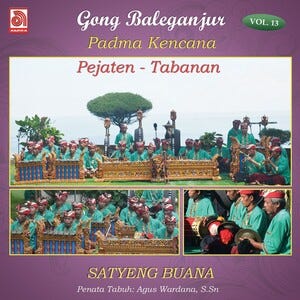EVERY GENRE PROJECT - February 7 - Gamelan beleganjur
Genre of the Day - Gamelan beleganjur
Album of the Day - Gong Baleganjur, Vol. 13: Satyeng Buana by Gong Padma Kencana (2014)
Irony has been less cruel and just plainly strange lately for me, which perhaps I should take as a positive omen, but never speak too soon. In the midst of listening to today’s hour-long album, I walked into my one class of the day (sorry ‘bout it)—Electronic Music and Dance Culture—and was taken aback to see various music students dragging several ornate instruments out of the room after seemingly a presentation. To my absolute shock, I quickly realized that they were instruments that formed a gamelan ensemble given what was written on the blackboard, and I didn’t really even have time to recover mentally before class started. Sure, gamelan music is probably Indonesia’s best-known musical export, and as a whole certainly isn’t niche by any means, but typically I’m not even early enough to class to see the remnants of whatever happened in the last class, and the literal one day I arrive early, it was related to gamelan?! Absolutely insane.
Whatever it means, it’s too bad I didn’t even come even earlier to witness the presentation, because I could’ve gotten the information for this article in real life and not from the annals of Google and RateYourMusic. Nonetheless, gamelan refers to the traditional orchestral ensemble of Java and Bali, consisting primarily—at least in the beleganjur tradition—of gongs in a wide range of sizes, membanophone drums (i.e. drums with a skin stretched over), and cymbals. Beleganjur more specifically is the closest parallel to Western military marching music. It’s also imbued with spiritual overtones, as it’s considered a way to keep spirits at bay, hence its additional use in funerary settings and other symbolically important rituals. Because of the necessity of portability given its use in marching processions, it’s the smallest of the traditional gamelan setups.
Not only can this music potentially keep spirits at bay, but after listening to it, I genuinely think it could be something of a musical defibrillator. If you think Death Grips or Converge is hard, you must listen to this. Breakneck tempo changes shift into frenetic clashes of cymbals and gongs, and the percussion is played at such a supersonic speed that this album totally challenged my preconceived expectations of how fast the human hand can move. The tracks—there are only four across the album, but all clock in at an average of fifteen minutes—are pretty much sonically indistinguishable, but that made for no less enjoyment. There is a frightening, distonal quality to it that I’m not sure is an inevitability of the melodic scale being used or a stylistic choice given the music’s function.
How this genre of music hasn’t been sampled to my knowledge is beyond me. Maybe I have to whip out Logic and be the first (I have done one assignment for my music production class). It goes to show the sheer level of musical fusion and depth of crate digging that’s left to be experienced. Perhaps aspiring for this music to be folded into Western production would strip a bit of its value, though; it’s obviously intriguing and fascinating enough on its own. But when a sound is as irresistibly unique as this, I can’t help but feel that more people should be exposed to it. Will your friend perhaps balk at receiving a Spotify link to a fifteen minute frenzy of gamelan? Perhaps. Do you miss 100% of the shots you don’t take? Always.




